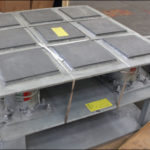Types & Sizes
Technical Information
Installation & Maintenance
Prior to Welding: Locate the slide plate base in the appropriate position on the existing steel surface. Place a protective covering on the graphite. Where seal welding is not required, follow the diagram shown which indicates 1/8” thick fillet weld, 1” long every 4” around entire perimeter of the base. For welding, use GMAW 0.035 wire or SMAW 3/32″ stick.
Where full seal welding is required, use a similar pattern of welding until a full weld is obtained. This method will prevent damage to the graphite. (A full weld will help prevent seepage of water between the slide bearing plate and the support structure.) Avoid overheating, which may destroy the bonding of the graphite to the base plate.
Installation in Concrete: Secure the top and bottom elements together with paper adhesive tape. Then attach the bottom element anchor bolts with wire to the form. After the bottom pour is made, repeat on top element. During the first expansive cycle, the tape will break.
Request a quote



















